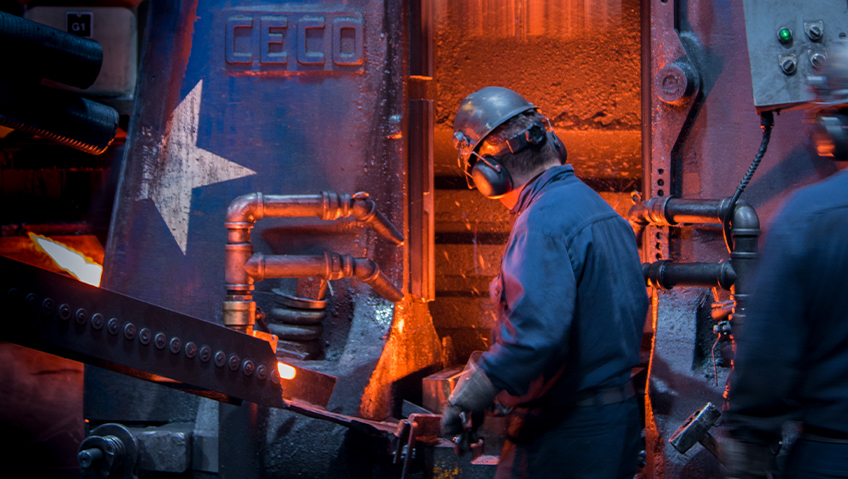Since 1864, the Johnston Boiler Company of Ferrysburg, Michigan has been laser-focused on custom-manufacturing the most efficient fire-tube boilers in the market. So confident is the company in its boilers’ longevity that it offers a 15-year warranty, virtually unheard of in the industry.
Johnston’s signature product is the highly efficient Scotch Marine fire-tube boiler. It features a water-backed construction design, meaning that all the surfaces are submerged in water, which reduces the refractory of the boiler, thereby creating higher efficiencies and reducing maintenance, both of which result in substantial cost savings for the user.
Johnston is the only company that designs and fabricates the entire customized package under one roof, including both the pressure vessel and the burner, which offers further cost savings to customers, while ensuring corners aren’t cut by a third-party manufacturer.
An environmentally friendly feature of a Johnston burner is its use of green technology. Johnston’s burners are specifically designed to offer reliable service with reduced nitrogen oxide and carbon dioxide emissions to meet or exceed standards set by the EPA.
And last but not least, before each boiler is shipped to the customer, it is assembled and fire-tested at the plant to ensure it meets all of the requested specifications.
In addition to fire-tube boilers, Johnston also manufactures ancillary equipment, including a full line of deaerators, surge tanks, blowdown tanks, and blowdown heat recovery systems.
It was our pleasure to reconnect with Thom Parker, Johnston’s Director of Sales, after having first met with him in 2017. At that time, he told us about the company’s incredible history, but for this feature he prefers to focus on the present with just a glance into the future.
However, for the benefit of new Construction in Focus readers, here is a brief recap. In 1864, John Watt Johnston, a direct descendant of James Watt, the Scottish engineer who developed the steam engine in the 1770s, purchased the Turnbull Boiler Works in Ferrysburg on the banks of Michigan’s Grand River and quickly established its reputation as an industry leader. Johnston’s boilers were instrumental in rebuilding Chicago after the Great Fire of 1871 and 60 of them were used in building the Panama Canal at the turn of the 20th century. It remained a family-owned company until 1974. In 1987 Johnston Boiler was purchased by Larry Hines, and today is part of the Hines Corporation.
In the 1990s when so many manufacturers closed their doors and moved offshore, Johnston stayed the course, and even reversed the trend by being in a position to sell boilers to offshore industries. Now Parker, as Director of Sales, is working with manufacturer’s representatives across North, Central and South America, Central America, the Middle East, and some African countries to sell those big green machines.
Although a non-disclosure agreement prevented him from speaking about it directly, he indicated he is currently working on a job for an off-shore energy sector company, and “if we get it, it will be the largest job in the history of our company.”
Johnston pioneered the Scotch Marine boiler system – a compact fire-tube design, originally intended for shipboard use, in sizes ranging from 50HP to 2500 HP – which is what Parker calls the “unsung hero” of industrial process manufacturing and health care sectors. Today food processors, distilleries, chemical manufacturers and resin manufacturers as well as hospitals and schools rely on this type of boiler, but no one notices them, he says, unless something goes wrong.
But thanks to the company’s focus on longevity and quality over quantity, things seldom go wrong with Johnston’s boilers. “We offer a 15-year warranty and follow up with customers for 30 years,” Parker says. “Industries have our product, and we maintain it to make sure it is meeting the requirements, and at the end of that process, they come to us and say, we need new equipment and we’re coming to you.”
Apart from quality and longevity, what really differentiates Johnston’s boilers from the competition is customization.
As Parker explains, it is important to understand that there is a basic design and it’s ready to go to market, but what Johnston will do is modify the standard design to meet the customer’s requirements. For example, certain parts can be moved to different locations on the equipment so as to accommodate the size and layout of the boiler room.
“A lot of our competition won’t do that. They say what you see is what you get,” Parker says. “That strategy works for them because it keeps the cost down, but customization works for us, and identifies us in the market to customers who have very specific needs.”
That, he maintains, is of paramount importance because valued relationships such as Johnston has developed require a collaborative approach on a long-term basis. Johnston, he says, does not take on a project and deliver it a month later; some projects can take two to three years to develop because the company is all about giving customers what they want.
One aspect of customization that is important for industry is having a boiler with the capability of alternating between fuel burning options – natural gas, propane, oil, or bio-fuels.
This is crucial if the operation of the boiler is tied to a critical process which, if required to shutdown, would cause the company to lose staggering sums of money. The cyber-attack on the Colonial Pipeline this past May is just one of the events that can cause energy-infrastructure interruption or prices to rapidly escalate.
Earlier in the year, a two-week cold snap with temperatures below 20°F in Tennessee saw a resulting surge in demand for home heating fuel and a curtailment of supplies. This created a situation where boilers in resin-producing plants that run 24 hours a day were forced to shut down.
That in turn created a shortage of the resin required to manufacture OSB (oriented strand board) products used for sheathing in the residential construction industry, causing construction in areas of the south-east to come to a halt. And this is just one example of the knock-on effect caused when a boiler has to shut down.
At the same time that the resin producing plants in Tennessee were forced to shut down, Texas was experiencing similar frigid temperatures which resulted in a curtailment of fuel, once again causing boilers to shut down and affecting ethanol and gasoline production.
“The ripple effect was seismic,” says Parker, “and millions and millions of dollars were lost in a matter of days.” Much of this loss was to companies whose boilers were dependent upon one type of fuel.
However, had those boilers been customized by Johnston so that they could switch between fuels, that economic fallout could have been avoided. In addition, having the option to choose between fuels means manufacturers can take advantage of fuel price fluctuations.
Another way Johnston is differentiating itself in the marketplace is by increasing capacity. Parker says that in the past customers had asked the company to design boilers for higher design pressures than anything currently produced.
Although Johnston could design the product, until then the company was not capable of lifting the heavier equipment, some of which might weigh in excess of 70 or even 80 tons, in order to assemble, fire-test and ship.
The current design for fire-tube boilers typically tops out at 350 psi, whereas water tube boilers, which supply industries such as large municipal utilities, can design boilers capable of operating pressures in excess of 2000 psi. While a fire-tube boiler could never be designed for pressures that high, new lifting equipment means that Johnston is capable of manufacturing boilers in the 400-600 psi range.
This demonstrates, he says, that Johnston is capable of entering the market segment that requires a higher range, but for which the extreme range produced by water tube boilers would not be necessary.
Chemical distillation, and power generation for smaller, on-site utilities are two examples of areas that require design pressures in the ranges that Johnston is now able to fabricate.
Parker cautions, however, that as the company grows its product, the most important thing is to maintain quality and dependability. That can never be sacrificed to achieve higher pressures, because once design changes are started, they can affect other areas, such as ability to produce steam or to control emissions.
“All those things have to come into play as a product is changed and that is how we evaluate carefully to make sure all those things are maintained.”
In conclusion, Parker says, “As we develop these products and go into new areas, it will continue to be very important to engage with the customer on design. We can’t just go off on our own and design something we ‘think’ the customer wants.
“We have to be collaborative with our customers, to really listen and communicate with them, so that as we conduct product development, our customers remain an integral part of the process.”






